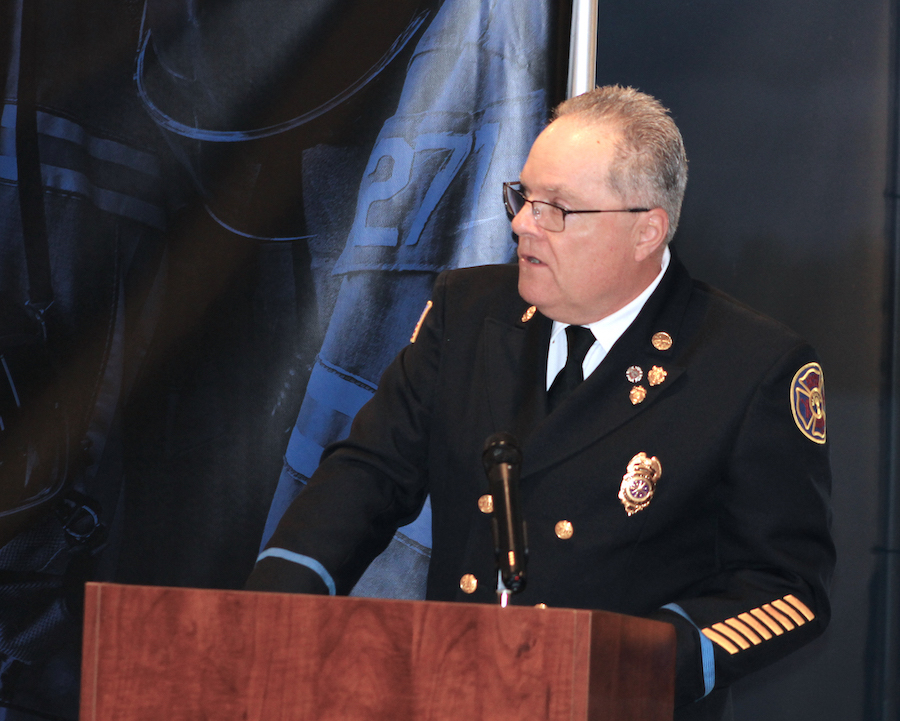Featured News - Current News - Archived News - News Categories
Story and Photo by Alice Gerard
Senior Contributing Writer
Children face hidden dangers as they try to navigate the online world, as well as the sometimes more blatant dangers of daily life.
In a program that was held on Nov. 9 titled “Keeping Children Safe,” Grand Island Police Officer in Charge Thomas Franz spoke about dangers online, as well as the threat of violence in schools, and Derek Staubitz, owner of Hybrid Defense, spoke about training children in self-defense. The program was organized by Grand Island High School senior Casey Walowitz, who said her goal was to provide “information regarding the protection of children, as well as the organizations that the donations from this event are going to.” Those organizations included Sandy Hook Promise, which focuses on the prevention of violence in schools, and ProtectUsKids, which is dedicated to protecting at-risk youth from cyber-related crimes.
Franz, who said that the use of social media has grown “exponentially,” shared usage statistics from 2020 that he described as coming from such sources as the FBI and the U.S. Secret Service:
√ Twitter/X: Almost 400 million users and it’s growing. Almost 200 million daily users.
√ Facebook: 1.9 billion daily users and 2.9 billion users monthly.
√ Snapchat: 300 million-plus daily users, averaging 5 million snaps per day.
√ TikTok: a billion monthly users. “Influencers on TikTok can make in excess of $5 million per year,” Franz said.
“What do people want to do when they see something? They pull out their phones. Because it’s monetized. I told you about TikTok. People making silly videos on a visual platform? Some of them aren’t just silly. They’re sexual or they’re bad. They’re making millions of dollars, going online, and making videos. If you have a monetized YouTube account, and you make a video, you’ll make money. That’s the first instinct these days. Everyone pulls a cell phone out and take a video.”
There are many dangers for children online, Franz said. One of the biggest dangers is sexting: “Twenty percent of 10-15-year-olds have sent at least one inappropriate photo, and 40% of children that age have sent a sexual photo of themselves.
“It’s important for parents to know what’s going on, but it’s also important for kids to realize that, once you post something online, it’s never going away. You may delete a Snapchat, or you may delete an Instagram post or a Facebook post, but all it takes is for somebody to do a snapshot of it, and it’s there forever. They are on the company servers forever. Law enforcement can subpoena stuff like that for investigations.
“For kids, it’s something to think about. You don’t think about consequences when you’re doing something like that. It can affect college, applying to college. It could affect your job. Everyone does background investigations now. One small bad choice could totally harm your life and your career.”
There are also benefits to social media for children and families, Franz said.
“Social media is used for good, and it’s used for bad, just like anything,” he said. “Earlier this year, social media was used to find a young lady. It’s a good thing for us and a great outcome. Law enforcement used social media to help facilitate a happy ending to that.
“It’s ever-evolving. As parents, as law enforcements, as kids, you have to see the bigger picture. Try to use it for good, not bad.”
Franz told parents, “You have to be involved in your kid’s life. I had access to my kids’ phones. They didn’t like it, but I could shut their phones off. I could monitor their activity. We have a responsibility to the next generations to teach them things and to be in their lives. We’re not doing it to micromanage them. We’re doing it to protect them.”
Another way to protect children from danger is through educating them about potential hazards and training them in effective self-defense techniques.
Staubitz explained, “Instilling confidence in children is important in helping them learn how to keep themselves safe.”
He described it as “confidence in an uncomfortable situation. We work on drills where we put ourselves in an uncomfortable position, and we try to work through that. We work with kids of all ages on defense. I want to show them a couple of options. What are you best at? That also builds the kid’s confidence.”
Students at Hybrid Defense, who range in age from young children to senior citizens, are taught methods for defending themselves from attackers. They are taught when to run and when to fight, as well as how to fight.
In the case of an attacker who is trying to get a child into a vehicle, “You fight on location,” Staubitz said. “Any time someone says to you, ‘You come with me or else,’ you fight there. The reason they want you to go to location 2 is because they are not comfortable with location 1.
“They’re scumbags. They’re not stupid. They came with a plan. It’s tragic, but that is the reality.
“At Hybrid Defense, we are all about building kids’ focus, discipline, ability to protect themselves, as well as their confidence in doing so. We do this through drills and games. I recommend that, if you don’t go to a martial arts school or a dojo or a gym or a wrestling competition, at least work the things that you want them to do and want them to have fun with at home. Practice ‘Where’s our meeting place?’ A tree in the yard. Don’t just ask them that. Make it a game. Have your aunt call and say, ‘Hey, the code word is this.’ Have the kids practice. The more repetitions, the safer the kids will be. Every kid knows that, if you’re on fire, you’re supposed to stop, drop, and roll.”
In an active shooter situation, the words Staubitz said he wants to be as well known as “stop, drop, and roll” are “run, hide and fight.”
Staubitz, who runs active shooter drills twice a year, explained, “The preferable goal is, for the most part, to be able to get out when possible. If it’s not safe for us to get out, we hide. We talk about how we hide. We talk about where to hide.”
“I told my kids that, if something like that happens, get out of the building,” Franz said. “I know protocols are in place for students to shelter in place or whatever, but that was my choice for my kids. You always want your kids to obey and listen to instruction. I said to my kids, ‘If you can get out safely, get out. If you can’t get out safely, listen to what your teachers and administrators are saying.”
Franz said that numerous police agencies participated in an active shooter drill in Grand Island High School. These police agencies included the Erie County Sheriff’s Department, the Grand Island Police, New York State Police, and Homeland Security.
“We ran a simulated shooting at the school,” Franz said. “We learned a whole lot about good things, bad things, things that we could do better. I know we’ve done a lot, going forward from that.”
He explained that there is no single “profile on the school shooter. It ran the gamut from different types of children: popular children, not popular children, introverts, extroverts. There was no single pattern that Secret Service could define as someone who could be the shooter.
“Attackers usually have multiple motives, the common one being a grievance with classmates. Most attackers experience psychological behavior and developmental symptoms. Based on my experiences in the last five or six years, what I’ve seen of mental health issues, they’ve risen drastically. Our mental health calls for services have gone up drastically. That’s true for all, from kids to adults. I don’t know what the cause for this is.
“Mass shootings are not random. They are planned, going all the way back to Columbine (Colorado, on April 20, 1999). It’s a long planning process. A lot of people missed many things. Law enforcement missed it. School administrators missed it. We missed a lot of things as parents, teachers, administrators.”
One way that parents can help to prevent potential violence is by securing their weapons, if there are any in the home.
“Access to weapons is a big thing. Many of the students who plotted and committed the crimes had access to weapons,” Franz said.
He noted school resource officers are in the schools to provide assistance and support: “At the schools, we have access. We do tell kids and inform parents that there are services available in Erie County and Western New York. Services can come from the Family Justice Center, Kids Escaping Drugs, Renaissance House, and mental health advocacy groups, such as NAMI – National Alliance on Mental Illness. There are plenty of resources out there for families and students and everyone to reach out, if needed.
“That’s an important element. Not only schools getting involved in that, but law enforcement has to get involved in that. When we get calls for service, we can’t be just about arresting people and locking them up. There has to be a community policing element to it. Law enforcement changes and society changes, and you have to change with it.”
Law enforcement looks for help and support from the community, as well, Franz said.
“If you see something, say something,” he noted. “It’s important for students, it’s important for parents, for everybody in any of the school buildings. Be a good witness. Call 911. I tell young cops to be a good recorder. Be a good visual recorder. Use your powers of observation. Giving information to law enforcement is very critical.”
Walowitz said she was grateful for the speakers, for teachers Amy Boutet and Cheryl Chamberlain, and for everyone who attended the event: “I am thankful for everyone who donated and gave their time to speak and just to attend the event. I’m excited to possibly continue this in the future and work to prevent violence toward children, whether in schools, online or in other threatening situations.”





























